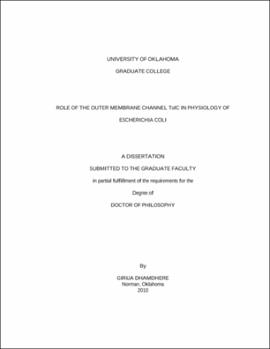| dc.contributor.advisor | Zgurskaya, Helen I | |
| dc.creator | Dhamdhere, Girija Rajeev | |
| dc.date.accessioned | 2019-04-27T21:34:14Z | |
| dc.date.available | 2019-04-27T21:34:14Z | |
| dc.date.issued | 2010 | |
| dc.identifier | 99308898302042 | |
| dc.identifier.uri | https://hdl.handle.net/11244/319040 | |
| dc.description.abstract | TolC is a versatile, multifunctional protein and in Gram-negative bacteria such as E.coli, it has been shown to participate in several functions like drug efflux, toxin secretion and has also been demonstrated to be important for survival in iron limiting conditions. This multifunctional nature of TolC makes it an attractive target for drug design and therefore it becomes imperative to understand the mechanism of TolC's multifunctional nature. | |
| dc.description.abstract | The first part of this dissertation is focused on understanding the physiological function of TolC in E.coli. We found that the loss of TolC induces stress on the cytoplasmic membrane and notably impairs cell division and growth in minimal medium. The TolC-dependent phenotype was further exacerbated by the loss of ygiB and ygiC genes expressed in the same operon as tolC and their homologs yjfM and yjfC located elsewhere on the chromosome. We found that the growth deficiency of tolC mutants is caused by the stress on the membrane, L-serine auxotrophy, and depletion of essential metabolites such as GSH and NAD+. We conclude that disruption of membrane functions caused by inactivation of TolC makes cells highly vulnerable to the challenges of aerobic glucose metabolism. The membrane stress in deltatolC cells leads to metabolic shut-down and growth arrest. The activity of YgiBC and YjfMC protects membranes from the stress and allows deltatolC mutants to resume growth on glucose. | |
| dc.description.abstract | The second part of this dissertation is focused on understanding how TolC is engaged into protein complexes. For this purpose we constructed chromosomal TolC cysteine mutants with a C-terminal six histidine tag. Cysteine replacements at positions Q352, D356, S363 and D374 were constructed as these residues have been predicted to lie at the TolC-MFP interaction interface. These chromosomal TolC cysteine mutants were expressed from the chromosomal native promoter and were functional. We used these mutants to study in vivo TolC-MFP interactions. Our co-purification and cross-linking experiments indicate that TolC is in close association with MFP, AcrA. However, all the cysteine residues except for TolCQ352C were readily labeled with fluorescent dye, indicating that TolC is freely available for interaction with MFPs. These in vivo studies strongly indicate that TolC-MFP interactions are highly dynamic and transient in nature. | |
| dc.format.extent | 164 pages | |
| dc.format.medium | application.pdf | |
| dc.language | en_US | |
| dc.relation.requires | Adobe Acrobat Reader | |
| dc.subject | Escherichia coli | |
| dc.subject | Membranes (Biology) | |
| dc.subject | Membrane proteins | |
| dc.subject | Gram-negative bacteria | |
| dc.title | Role of the outer membrane channel TolC in physiology of Escherichia coli | |
| dc.type | text | |
| dc.type | document | |
| dc.thesis.degree | Ph.D. | |
| ou.group | College of Arts and Sciences::Department of Chemistry and Biochemistry | |
